For all the effort many of us make to purchase healthier, more sustainably raised meats and produce these days, we often pay little attention to the quality of the condiments we put on top of them.
Think about that jar of mayonnaise in your refrigerator. You know the one. It’s been on a shelf for a month — or more. How about those old bottles of ketchup, mustard, and salad dressing? Surely your steaks and salads deserve better than that.
Not only are homemade dressings and sauces healthier than their store-bought, processed, and often additive-filled counterparts, they taste better, too. Try a sumptuous spoonful of creamy, eggy homemade mayonnaise and you’ll immediately notice a difference from the artificial sweetness and bland flavor of the commercial stuff.
Plus, making homemade condiments is easy (none of these recipes requires a big time commitment). And it can be a lot of fun. Grab your kids or friends and behold emulsifying magic as mayo materializes before your very eyes. And while it may be cheaper to buy a bottle of sauce manufactured in a plant, nothing quite beats the gratification of tasting ketchup made from tomatoes from your garden or the local farmers’ market.
So step away from the center aisles of the grocery store. Instead, create healthier and more satisfying versions of your favorite sauces or dressings using whole, fresh ingredients. Your burgers and salads will thank you.
Condiment Recipes
Ketchup
As a sweet sauce, a little ketchup can go a long way. You can moderate your sugar intake by experimenting with variations of this recipe. Reduce the amount of sugar by half, or try using 3/4 cup honey or 2/3 cup molasses (or even finely ground figs or dates, to taste) as a healthier sweetener. Note: Any liquid ingredients will make your ketchup a bit thinner.

Makes 2 cups | Preparation time 75 minutes
Ingredients
- 2 1/4 lbs. plum tomatoes (about 6 to 8 large)
- 1 1/2 cups distilled white vinegar
- 2 1/2 tsp. coarse sea salt or kosher salt
- 1 cup sugar (or to taste)
- 1 tbs. grated onion or 1 tsp. onion powder
- 1/2 tsp. mustard powder
- 1/4 tsp. ground cinnamon
- 1/4 tsp. ground cloves
- 1/4 tsp. ground allspice
- 1/4 tsp. ground black pepper
Directions
- Bring a large pot of water to a boil.
- Add the tomatoes and cook until the skins break and the flesh becomes soft, five to 10 minutes. Drain the tomatoes and press through a fine-mesh food mill or sieve to remove the skins and seeds.
- Pour the sieved tomatoes into a medium-size saucepan. Add the vinegar and salt. Stir to combine.
- Bring the tomato mixture to a boil and then whisk in the sugar, onion, and spices.
- Return to a low boil, stirring occasionally, and cook about one hour until the mixture has reduced to one-fourth the original amount and thickened. Some tomatoes are more watery than others, so additional cooking might be necessary to reduce moisture.
- Your ketchup should be the consistency of tomato purée, slightly thinner than bottled ketchup; it will thicken when it cools.
- Pour into a sterilized jar. Cover and refrigerate for up to one month.
Note: A food mill separates these skins and seeds from the pulp, while a food processor chops and purées everything together. The biggest difference is texture; with a food mill you get a refined, smooth sauce, while a food processor turns out a slightly aerated, granular sauce. When it comes to ketchups, barbecue sauces, and fruit butters, you are better off using the food mill or a fine sieve.
Spicy Brown Mustard
Described in winelike terms, this mustard is rich and complex — spicy, tangy, sweet, and nutty, with exotic undertones.
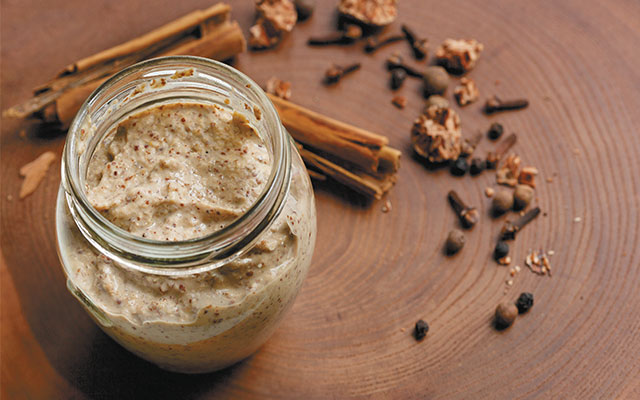
Makes 1 /4 cups | Preparation time 10 minutes, plus one to two days sitting
Ingredients
- 1/2 cup water
- 1 cup crushed brown mustard seeds or ¾ cup whole brown mustard seeds, finely ground
- 1/2 cup red-wine vinegar
- 1 tsp. coarse sea salt or kosher salt
- 1/8 tsp. ground cinnamon
- 1/8 tsp. ground cloves
- 1/8 tsp. ground nutmeg
- 1/8 tsp. ground allspice
- 1/4 tsp. black pepper (optional)
Directions
- Mix all the ingredients in a nonreactive glass or ceramic mixing bowl.
- Cover with plastic wrap and let sit at room temperature for one to two days so that the mustard begins to mellow and the flavors meld. (If you find that the final mustard still seems slightly watery after sitting at room temperature for one or two days, pour it into a blender or food processor and process until smooth.)
- Transfer to an airtight container. Cover and refrigerate overnight; store in the refrigerator for up to six months.
Almond Butter
Try this spread with apricot jam for a new twist on a PB and J sandwich. Note: Grinding nuts into paste can be taxing on your food processor. Give it a rest for a few minutes in the middle of grinding so that it doesn’t overheat.
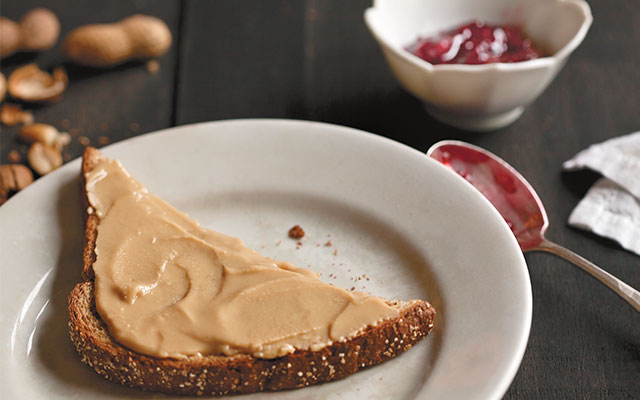
Makes 1 1/2 cups | Preparation time 30 minutes
Ingredients
- 1/3 cup coconut oil
- 2 cups blanched, slivered almonds
- 1 tsp. coarse sea salt or kosher salt
- 3 tbs. honey
- 1/4 tsp. ground cinnamon (optional)
Directions
- Preheat the oven to 350 degrees F.
- Gently warm the coconut oil in a small saucepan over low heat until it melts. Toss the blanched almonds with 1 tablespoon of the melted oil.
- Spread the nuts on a cookie sheet in a single layer. Bake for eight to 10 minutes until golden brown, stirring at least once to ensure even toasting. Keep a close eye on the almonds as they toast to make sure they don’t burn.
- Remove from the oven and let cool to room temperature.
- Place the toasted almonds and the salt in a food processor and grind the nuts into a fine paste, about three to five minutes.
- Add the honey, remaining oil, and cinnamon.
- Continue processing until the butter becomes smooth. You can also add more coconut oil for a thinner consistency; experiment with adding 1 tablespoon at a time, up to 5 additional tablespoons.
- Transfer to a jar and store in the refrigerator for up to two months. Remove from the refrigerator 10 to 15 minutes before use for easier spreading.
Mayonnaise
Watching eggs and oil swirl together and emulsify into thick, creamy mayonnaise seems almost like a magic trick. And the flavor is delightful.
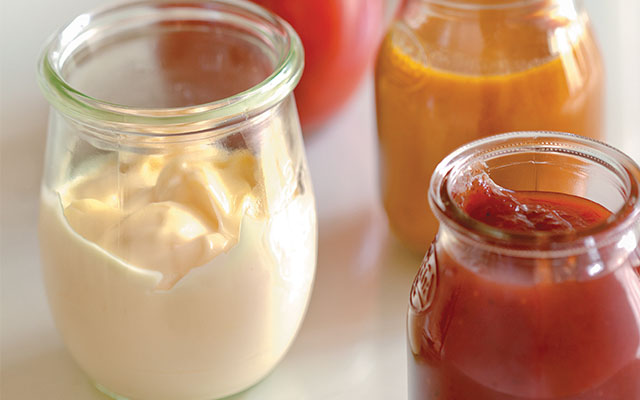
Makes 1 cup | Preparation time 10 minutes
Ingredients
- 2 raw egg yolks, at room temperature
- 1/2 tsp. coarse sea salt or kosher salt
- 1/2 tsp. mustard powder or Dijon mustard
- 1 tsp. lemon juice
- 1 tbs. white-wine vinegar or cider vinegar
- 1 cup olive oil
- Pinch of sugar (optional)
Directions
- Place the egg yolks in a blender or mini food processor. (Because this recipe makes only 1 cup, a full-size food processor may be too big to aerate the eggs properly.) You can also whisk the mixture by hand.
- Process or whisk the egg yolks until they are light yellow and frothy. Add the salt, mustard powder, lemon juice, and vinegar and process or whisk until blended.
- With the motor running (or whisking vigorously), slowly drizzle in the oil in a light, steady stream. The mixture will thicken as the oil emulsifies, but don’t stop until you have added the entire cup of oil. When all the oil is blended, stop the motor (or take a whisking break), open the bowl, and taste.
- Add more salt and sugar, if desired.
- Serve after one hour or refrigerate for up to three days.
Balsamic Vinaigrette
On its own, balsamic vinegar can lack the acidic pop to make a good vinaigrette. I usually add a little red-wine vinegar to help balance the dressing. This dressing is incredibly versatile. Try using it as a marinade for chicken. (For more salad-dressing recipes, check out “Healthy Salad Dressing“.)
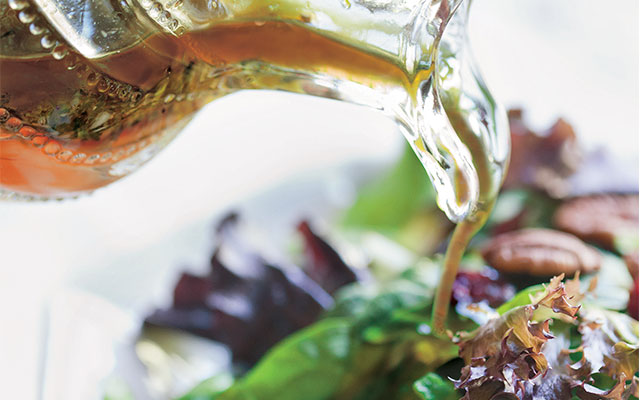
Makes 1 1/4 cup | Preparation time 10 minutes
Ingredients
- 1/4 cup balsamic vinegar
- 2 tbs. red-wine vinegar
- 1 tsp. Dijon mustard
- 1 tsp. dried basil or 2 tsp. minced fresh basil
- 1 tsp. dried parsley flakes
- 2 tsp. minced fresh parsley
- 1/2 tsp. sugar (optional)
- 3/4 cup extra-virgin olive oil
- 1/2 tsp. sea salt or kosher salt, or to taste
- Freshly ground pepper, to taste
Directions
- In a small mixing bowl, combine the balsamic vinegar, red wine vinegar, mustard, basil, parsley, and sugar (if using). Whisk to combine.
- Slowly add the olive oil, whisking constantly to thoroughly blend.
- Season with salt and pepper and serve. Or better yet, if you have time to let it rest before serving, the flavors will intensify. I like to give my vinaigrette about an hour to rest to fuse the flavors.
- If you have any unused dressing, cover it and store it in the refrigerator for up to three days. After that, the flavor begins to wane.
Note: The mustard creates an emulsion, meaning the liquid stays blended instead of separating immediately, but you may need to stir the dressing again just before serving.
Spice Up Your Mayo
Mayonnaise can be made with any variety of oils. Experiment to decide which oil is your favorite. You can even try infused oils like red pepper or basil to change the flavor. Be creative! Here are some other variations you might like to try.
Chipotle Mayonnaise: Add 1 teaspoon adobo sauce from a jar of chipotles en adobo to the finished mayonnaise. You get all the flavor without all the heat.
Piquant Mayonnaise: Add 1 teaspoon grated onion to the finished mayonnaise.
Curry Mayonnaise: Add 2 teaspoons mild curry powder when you add the mustard powder at the beginning of the recipe.
Tarragon Mayonnaise: Substitute tarragon vinegar for white-wine vinegar and add 1 tablespoon minced fresh tarragon to the finished mayonnaise.
Harissa Mayonnaise: Harissa is a North African condiment made from hot chilies. You can find it online or in specialty stores. Add 1 tablespoon harissa to your finished mayonnaise and stir to combine. It makes a great spread for turkey and Havarti cheese sandwiches.
Herbed Mayonnaise: Mince and combine 1 tablespoon each to finished mayonnaise: parsley, chives, tarragon, red bell pepper, and hard-boiled egg (optional). Add 1 tablespoon sweet pickle relish, and stir until well blended. (Pictured above)|
Tartar Sauce
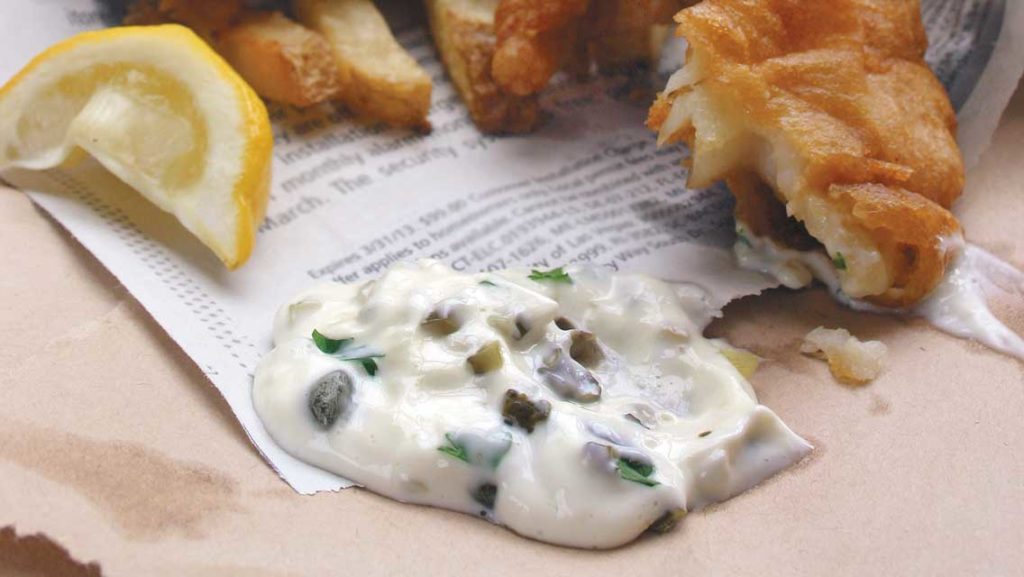
Makes 1 1/3 cups | Preparation time 15 minutes
Ingredients
- 1 cup homemade mayonnaise
- 2 tbs. minced dill pickle
- 2 tbs. capers, rinsed and chopped (optional)
- 1 tbs. minced fresh parsley
- 1 tbs. lemon juice
- 1 tsp. grated onion
Directions
- Mix all the ingredients together in a small mixing bowl. Chill until ready to use. Store in the refrigerator for up to one week.
Carolina-Style Barbecue Sauce
Carolina-style barbecue has a decidedly piquant flavor in comparison to its ketchup-based cousins. This sauce is great with grilled chicken, and it makes a mean pulled-pork sauce. You can even use it as a marinade before grilling. Substitute a ½ cup honey or ½ cup maple syrup for the granulated sugar, if you wish.
Makes 2 cups | Preparation time 15 minutes
Ingredients
- 3/4 cup yellow mustard
- 1/2 cup granulated sugar
- 1/4 cup packed brown sugar
- 1 cup cider vinegar
- 1/4 cup water
- 1 tsp. hot paprika
- 1/4 tsp. red pepper flakes
- 1/4 tsp. ground black pepper
- 3/4 tsp. coarse sea salt or kosher salt
Directions
- Mix all the ingredients in a medium-size saucepan. Stir to combine.
- Bring to a boil over high heat and then lower the heat and simmer for 10 minutes.
- The sauce can be used immediately or refrigerated for up to one month. Be sure to cool it in the refrigerator before using as a marinade.
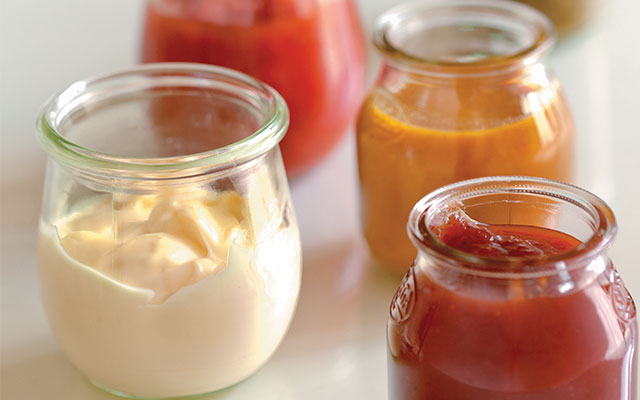
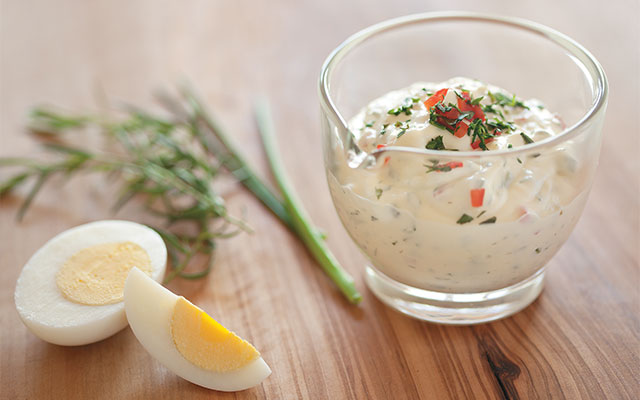
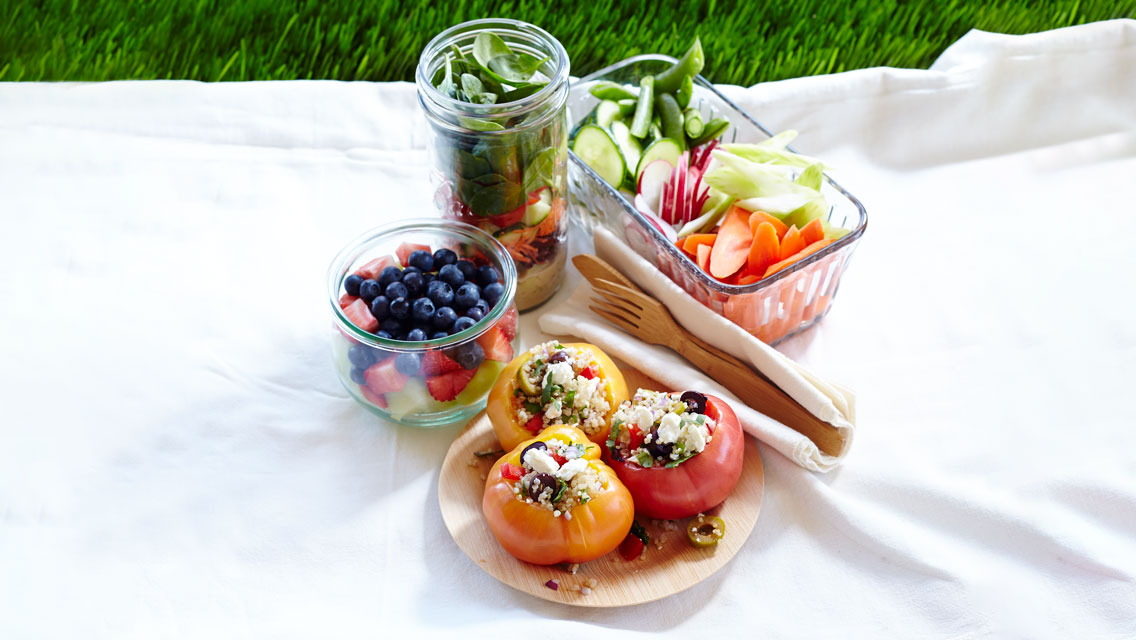

This Post Has 0 Comments